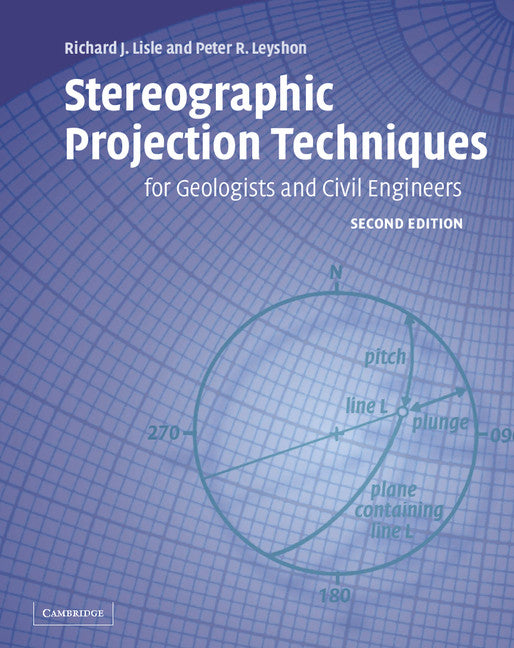Freshly Printed - allow 8 days lead
Couldn't load pickup availability
Stereographic Projection Techniques for Geologists and Civil Engineers
A straightforward introduction to stereographic projection techniques for students of geology and civil engineering.
Richard J. Lisle (Author), Peter R. Leyshon (Author)
9780521535823, Cambridge University Press
Paperback, published 1 April 2004
124 pages, 257 b/w illus.
28 x 21 x 0.7 cm, 0.29 kg
'… highly recommended to the readers of this journal, either as a reference text for the practicing engineering geologist or as a supplement for courses in engineering geology or the hydrogeology of fractured rocks. … The style of writing … is remarkably good and free of the jargon of structural geology … the authors provide simple and elegant definitions when the occasion calls for them. … informative and well written. … Lisle and Leyshon have written a fine and comprehensive introduction to a difficult topic. … the book is well worth its modest price.' Environmental and Engineering Geoscience
The stereographic projection is an essential tool in the fields of structural geology and geotechnics, which allows three-dimensional orientation data to be represented and manipulated. This book has been designed to make the subject as accessible as possible. It gives a straightforward and simple introduction to the subject and, by means of examples, illustrations and exercises, encourages the student to visualise the problems in three dimensions. Students of all levels will be able to work through the book and come away with a clear understanding of how to apply these vital techniques. This revised edition contains additional material on geotechnical applications, improved illustrations and links to useful web resources and software programs. It will provide students of geology, rock mechanics, geotechnical and civil engineering with an indispensable guide to the analysis and interpretation of field orientation data.
Preface
Acknowledgements
1. Geological structures of planar type
2. Measuring and recording the orientation of planar structures
3. Geological structures of linear type
4. Measuring and recording the orientation of lines
5. Why do we need projections?
6. Idea of stereographic projection
7. Approximate method of plotting lines and planes
8. Exercises 1
9. The stereographic net
10. Precise method of plotting planes. Great circles and poles
11. Precise methods for plotting lines 1. Where the plunge of the line is known
12. Precise methods for plotting lines 2. Where the line is known from its pitch
13. The intersection of two planes
14. Plane containing two lines
15. Apparent dip
16. The angle between two lines
17. The angle between two planes
18. The plane that bisects the angle between two planes
19. Projecting a line onto a plane
20. Stereographic and equal-area projections
21. The polar net
22. Analysing folds 1. Cylindricity and plunge of axis
23. Analysing folds 2. Inter-limb angle and axial surface
24. Analysing folds 3. Style of folding
25. Analysing folds 4. The orientation of folds
26. Folds and cleavage
27. Analysing folds with cleavage
28. Faults 1. Calculating net slip
29. Faults 2. Estimating stress directions
30. Cones/small circles
31. Plotting a cone
32. Rotations about a horizontal axis
33. Example of rotation about a horizontal axis. Restoration of tilt of beds
34. Example of rotation. Restoring palaeocurrents
35. Rotation about an inclined axis
36. Example of rotation about an inclined axis. Borehole data
37. Density contouring on stereograms
38. Superposed folding 1
39. Superposed folding 2. Sub-area concept
40. Example of analysis of folds. Bristol area
41. Geometrical analysis of folds. Examples from SW England
42. Example of analysis of jointing. Glamorgan coast
43. Geotechnical applications. Rock slope stability
44. Assessing plane failure. Frictional resistance
45. Assessing plane failure. Daylighting
46. Assessing wedge failure
47. Exercises 2
48. Solutions to exercises
Appendices
Availability of computer programs for plotting stereograms
Further reading
Index.
Subject Areas: Civil engineering, surveying & building [TN], Geology & the lithosphere [RBG]


